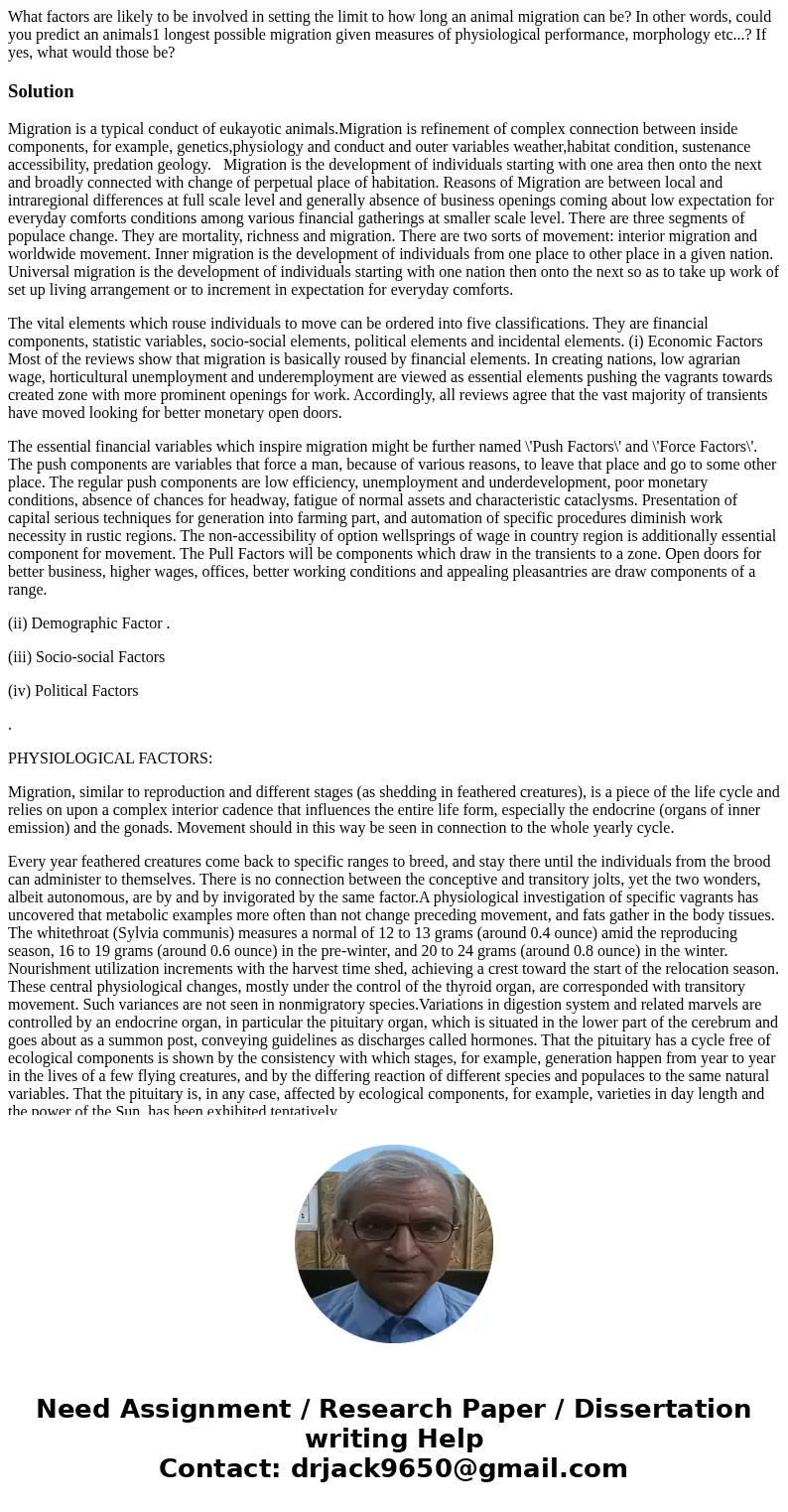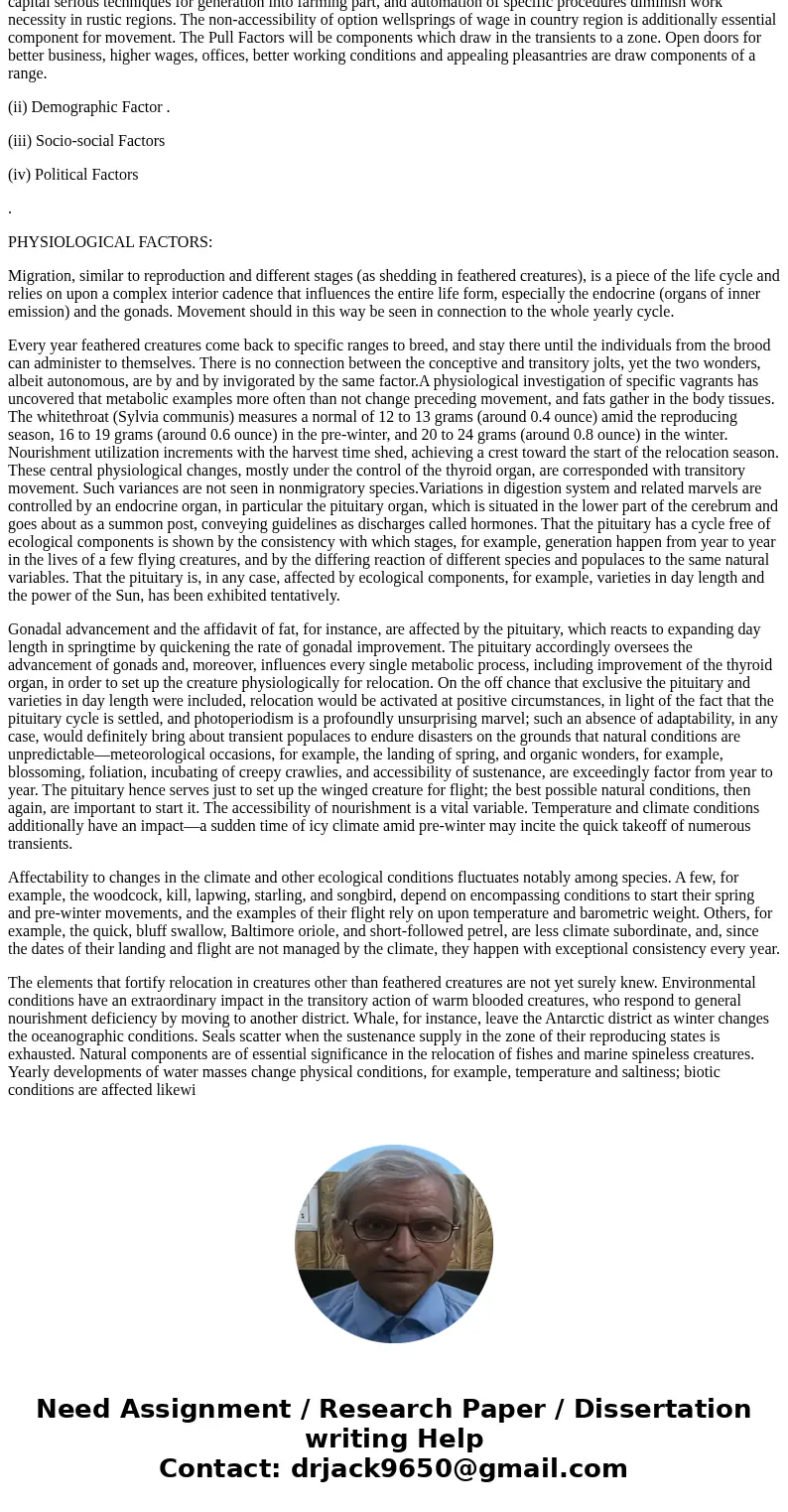What factors are likely to be involved in setting the limit
Solution
Migration is a typical conduct of eukayotic animals.Migration is refinement of complex connection between inside components, for example, genetics,physiology and conduct and outer variables weather,habitat condition, sustenance accessibility, predation geology. Migration is the development of individuals starting with one area then onto the next and broadly connected with change of perpetual place of habitation. Reasons of Migration are between local and intraregional differences at full scale level and generally absence of business openings coming about low expectation for everyday comforts conditions among various financial gatherings at smaller scale level. There are three segments of populace change. They are mortality, richness and migration. There are two sorts of movement: interior migration and worldwide movement. Inner migration is the development of individuals from one place to other place in a given nation. Universal migration is the development of individuals starting with one nation then onto the next so as to take up work of set up living arrangement or to increment in expectation for everyday comforts.
The vital elements which rouse individuals to move can be ordered into five classifications. They are financial components, statistic variables, socio-social elements, political elements and incidental elements. (i) Economic Factors Most of the reviews show that migration is basically roused by financial elements. In creating nations, low agrarian wage, horticultural unemployment and underemployment are viewed as essential elements pushing the vagrants towards created zone with more prominent openings for work. Accordingly, all reviews agree that the vast majority of transients have moved looking for better monetary open doors.
The essential financial variables which inspire migration might be further named \'Push Factors\' and \'Force Factors\'. The push components are variables that force a man, because of various reasons, to leave that place and go to some other place. The regular push components are low efficiency, unemployment and underdevelopment, poor monetary conditions, absence of chances for headway, fatigue of normal assets and characteristic cataclysms. Presentation of capital serious techniques for generation into farming part, and automation of specific procedures diminish work necessity in rustic regions. The non-accessibility of option wellsprings of wage in country region is additionally essential component for movement. The Pull Factors will be components which draw in the transients to a zone. Open doors for better business, higher wages, offices, better working conditions and appealing pleasantries are draw components of a range.
(ii) Demographic Factor .
(iii) Socio-social Factors
(iv) Political Factors
.
PHYSIOLOGICAL FACTORS:
Migration, similar to reproduction and different stages (as shedding in feathered creatures), is a piece of the life cycle and relies on upon a complex interior cadence that influences the entire life form, especially the endocrine (organs of inner emission) and the gonads. Movement should in this way be seen in connection to the whole yearly cycle.
Every year feathered creatures come back to specific ranges to breed, and stay there until the individuals from the brood can administer to themselves. There is no connection between the conceptive and transitory jolts, yet the two wonders, albeit autonomous, are by and by invigorated by the same factor.A physiological investigation of specific vagrants has uncovered that metabolic examples more often than not change preceding movement, and fats gather in the body tissues. The whitethroat (Sylvia communis) measures a normal of 12 to 13 grams (around 0.4 ounce) amid the reproducing season, 16 to 19 grams (around 0.6 ounce) in the pre-winter, and 20 to 24 grams (around 0.8 ounce) in the winter. Nourishment utilization increments with the harvest time shed, achieving a crest toward the start of the relocation season. These central physiological changes, mostly under the control of the thyroid organ, are corresponded with transitory movement. Such variances are not seen in nonmigratory species.Variations in digestion system and related marvels are controlled by an endocrine organ, in particular the pituitary organ, which is situated in the lower part of the cerebrum and goes about as a summon post, conveying guidelines as discharges called hormones. That the pituitary has a cycle free of ecological components is shown by the consistency with which stages, for example, generation happen from year to year in the lives of a few flying creatures, and by the differing reaction of different species and populaces to the same natural variables. That the pituitary is, in any case, affected by ecological components, for example, varieties in day length and the power of the Sun, has been exhibited tentatively.
Gonadal advancement and the affidavit of fat, for instance, are affected by the pituitary, which reacts to expanding day length in springtime by quickening the rate of gonadal improvement. The pituitary accordingly oversees the advancement of gonads and, moreover, influences every single metabolic process, including improvement of the thyroid organ, in order to set up the creature physiologically for relocation. On the off chance that exclusive the pituitary and varieties in day length were included, relocation would be activated at positive circumstances, in light of the fact that the pituitary cycle is settled, and photoperiodism is a profoundly unsurprising marvel; such an absence of adaptability, in any case, would definitely bring about transient populaces to endure disasters on the grounds that natural conditions are unpredictable—meteorological occasions, for example, the landing of spring, and organic wonders, for example, blossoming, foliation, incubating of creepy crawlies, and accessibility of sustenance, are exceedingly factor from year to year. The pituitary hence serves just to set up the winged creature for flight; the best possible natural conditions, then again, are important to start it. The accessibility of nourishment is a vital variable. Temperature and climate conditions additionally have an impact—a sudden time of icy climate amid pre-winter may incite the quick takeoff of numerous transients.
Affectability to changes in the climate and other ecological conditions fluctuates notably among species. A few, for example, the woodcock, kill, lapwing, starling, and songbird, depend on encompassing conditions to start their spring and pre-winter movements, and the examples of their flight rely on upon temperature and barometric weight. Others, for example, the quick, bluff swallow, Baltimore oriole, and short-followed petrel, are less climate subordinate, and, since the dates of their landing and flight are not managed by the climate, they happen with exceptional consistency every year.
The elements that fortify relocation in creatures other than feathered creatures are not yet surely knew. Environmental conditions have an extraordinary impact in the transitory action of warm blooded creatures, who respond to general nourishment deficiency by moving to another district. Whale, for instance, leave the Antarctic district as winter changes the oceanographic conditions. Seals scatter when the sustenance supply in the zone of their reproducing states is exhausted. Natural components are of essential significance in the relocation of fishes and marine spineless creatures. Yearly developments of water masses change physical conditions, for example, temperature and saltiness; biotic conditions are affected likewi


 Homework Sourse
Homework Sourse